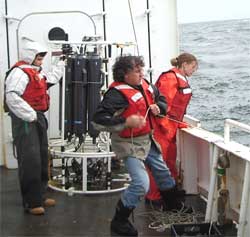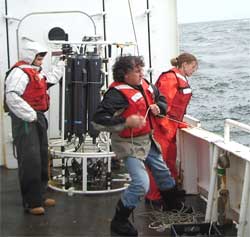“The hardest part of the job is scheduling – figuring out how long it takes to do each task, keeping projects on target, scheduling meals and scheduling watches,” said the doctoral student at the University of Rhode Island’s Graduate School of Oceanography. “You don’t want to schedule heavy duty work in the middle of lunch or no one will be happy.”
Pfeiffer-Herbert accepted the job of chief scientist – a role few graduate students undertake – for three research cruises aboard URI’s 185-foot research vessel Endeavor, each of which were to spend nearly a week collecting data around-the-clock in and around Rhode Island Sound. The second cruise has just been completed, and plans are now under way for the last one.
The research is aimed at gaining an understanding of the interaction of water moving between the estuaries along the coast and the deeper ocean on the continental shelf. A native of Acme, Wash., Pfeiffer-Herbert said this data is vital to understanding the movement of fish larvae in Rhode Island waters.
“Fish larvae can’t swim across horizontal currents and tides, but they can swim quite well in the vertical water column, so they can potentially control how deep they are,” she explained. “That’s important because currents can go different directions at different depths, and being at the surface or at the bottom can send them in a totally different trajectory.”
As chief scientist, Pfeiffer-Herbert is responsible for organizing the entire cruise, from recruiting participants to ensuring that all of the scientific activities are completed. For her May cruise, her research team included three URI graduate students, four URI undergraduate students, a high school student and an elementary school teacher. Together they deployed numerous scientific instruments in the water, downloaded data from instruments that had been in the water for several months, and began the data analysis.
Not everything went perfectly, however. A net that was used to collect plankton in the water at different depths didn’t operate correctly, so she had to improvise a way to fix it. And the large number of younger students participating in the project required regular attention to keep them motivated and on task. Yet Pfeiffer-Herbert is looking forward to doing it again in November, in part because she is collecting some useful data.
“We’re getting a good picture of the general flow of water through Rhode Island Sound. There is surprisingly little known about the basic patterns of water movement in the area,” she said. “We’re finding that source waters are coming over from the east and southeast of Rhode Island Sound, and the main exit points are close to Block Island and Point Judith.”
Those results suggest that fish larvae entering Narragansett Bay most likely come from somewhere near Buzzard’s Bay and flow into Narragansett Bay through the East Passage.
“The movement of water influences what fish species come here,” Pfeiffer-Herbert said.
As she prepares for her next stint as chief scientist, the URI student is also looking to the future. She expects to complete her doctorate in 2011 and aims for a career in academia, where she will likely find herself serving as chief scientist again and again.
“The whole time leading up to a cruise, I’m running around like crazy making sure everything is ready, but once I’m out at sea it’s relaxing,” she said. “It’s nice to be out on the water.”
Pictured above
URI graduate student Anna Pfeiffer-Herbert (right) observes the retrieval of an oceanographic measuring device by URI Professor Christopher Kincaid, as student Andrew Walker (left) looks on.

